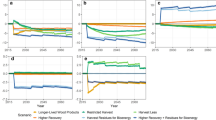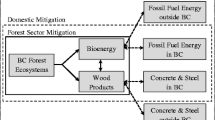Abstract
This paper summarizes studies of carbon (C) mitigation potential and costs of about 40 forestry options in seven developing countries. Each study uses the same methodological approach – Comprehensive Mitigation Assessment Process (COMAP) – to estimate the above parameters between 2000 and 2030. The approach requires the projection of baseline and mitigation land-use scenarios. Coupled with data on a per ha basis on C sequestration or avoidance, and costs and benefits, it allows the estimation of monetary benefit per Mg C, and the total costs and carbon potential. The results show that about half (3.0 Pg C) the cumulative mitigation potential of 6.2 Petagram (Pg) C between 2000 and 2030 in the seven countries (about 200× 106 Mg C yr-1) could be achieved at a negative cost and the remainder at costs ranging up to $100 Mg C-1. About 5 Pg C could be achieved, at a cost less than $20 per Mg C. Negative cost potential indicates that non-carbon revenue is sufficient to offset direct costs of these options. The achievable potential is likely to be smaller, however, due to market, institutional, and sociocultural barriers that can delay or prevent the implementation of the analyzed options.
Similar content being viewed by others
References
Asian Development Bank: 1998, Asia Least-cost Greenhouse Gas Abatement Strategy (ALGAS) 1998 Final Summary Report. Manila, Philippines.
Brazil CC web site: www.mct.br/clima/ingles/communic_old/amazinpe.htm
Boer, R.: 2001, 'Economic assessment of mitigation options for enhancing and maintaining carbon sink capacity in Indonesia', Mitigation and Adaptation Strategies for Global Change 6, 257-290.
Brown, S., Sathaye, J., Cannell, M. and Kauppi, P.: 1996, 'Management of forests for mitigation of greenhouse gas emissions', in R. Watson, M. Zinyowera and R. Moss (eds.), Climate Change 1995: Contribution of Working Group II to the Second Assessment Report of the Intergovernmental Panel on Climate Change, Cambridge University Press.
Brown, S., Masera, O. and Sathaye, J.: 2000, 'Project-based activities', in R. Watson, I. Noble, B. Bolin, N. Ravindranath, D. Verardo and D. Dokken (eds.), Land Use, Land-Use Change, and Forestry, A special report of the Intergovernmental Panel on Climate Change, Cambridge University Press, 377 pp.
Da Motta, S., Young, C. and Ferraz, C.: 1999, Clean Development Mechanism and Climate Change: Cost Effectiveness and Welfare Maximization in Brazil, Report to the World Resources Institute, Institute of Economics, Federal University of Rio de Janeiro, Brazil, 42 pp.
Fearnside, P.M.: 1995, 'Global warming response options in Brazil's forest sector: Comparison of project-level costs and benefits', Biomass and Bioenergy 8(5).
Fearnside, P.M.: 2001, 'The potential of Brazil's forest sector for mitigating global warming under the Kyoto protocol', Mitigation and Adaptation Strategies for Global Change 6, 355–372.
Kadekodi, G.K. and Ravindranath, N.H.: 1995, Macro-economic Analysis of Forestry Options on Carbon Sequestration in India, Working Paper E/173/95, Institute of Economic Growth, Delhi University Enclave, Delhi.
Kauppi, P. and Sedjo, R. et al.: 2001, 'Technical and economic potential of options to enhance, maintain and manage biological carbon reservoirs and geo-engineering', in B. Metz and O. Davidson (eds.), Working Group III Contribution to the Intergovernmental Panel on Climate Change (IPCC) Third Assessment Report. Cambridge University Press.
Lasco, R.D. and Pulhin, F.B.: 2001, 'Climate change mitigation activities in the Philippine forestry sector: Application of the COMAP model', Mitigation and Adaptation Strategies for Global Change 6, 313–334.
Makundi, W.R.: 2001, 'Carbon mitigation potential and costs in the forest sector in Tanzania', Mitigation and Adaptation Strategies for Global Change 6, 335–353.
Makundi, W.R. and OKiting'ati, A.: 2000, 'Greenhouse gas emissions and carbon sequestration in the forest sector of Tanzania', LBNL-43966. Submitted to: Climatic Change.
Masera, O.R., Ceron, A.D. and Antonio Ordonez, J.: 2001, 'Forestry mitigation options for Mexico: Finding synergies between national sustainable development priorities and global concerns', Mitigation and Adaptation Strategies for Global Change 6, 291–312.
Masera, O., Ordonez, M. and Dirzo, R.: 1997, 'Carbon emissions from Mexican forests: Current situation and long-term scenarios', Climatic Change 35(3).
MOF: 1996, Forestry Statistics of Indonesia 1994/95 – Agency for Forest Inventory and Land Use Planning, Ministry of Forestry, Jakarta, Indonesia.
Moomaw, W.R., Moreira, J.R. et al.: 2001, 'Technological and economic potential of greenhouse gas emissions reduction', in B. Metz and O. Davidson (eds.), Working Group III Contribution to the Intergovernmental Panel on Climate Change (IPCC) Third Assessment Report. Cambridge University Press.
Meyers, S., Sathaye, J., Lehman, B., Schumacher, K., van Vliet, O. and Moreira, J.: 2000, Preliminary Assessment of Potential CDM Early Start Projects in Brazil, LBNL Report – 46120
Pinard, M. and Putz, F.: 1997, 'Monitoring carbon sequestration benefits associated with reducedimpact logging project in Malaysia', Mitigation and Adaptation Strategies for Global Change 2, 203–215.
Ravindranath, N.H., Sundha P. and Rao, S.: 2001, 'Forestry for sustainable biomass production and carbon sequestration in India', Mitigation and Adaptation Strategies for Global Change 6, 233–256.
Sampson, R.N., Scholes, R.J. et al.: 2000, 'Additional human-induced activities – Article 3.4. pp. 181–281', in R.T. Watson et al. (eds.), Land Use, Land-use Change, and Forestry, A Special Report of the Intergovernmental Panel on Climate Change. Cambridge University Press, 377 pp.
Sathaye, J.A. and Bouille, D. et al.: 2001, 'Barriers, opportunities, and market potential of technologies and practices', in B. Metz and O. Davidson (eds.), Working Group III Contribution to the Intergovernmental Panel on Climate Change (IPCC) Third Assessment Report. Cambridge University Press.
Sathaye, J.A. and Makundi, W.R. (eds.): 1995, 'Forestry and climate change', Biomass and Bioenergy 8(5), 279–393.
Sathaye, J.A., Makundi, W.R. and Andrasko, K.E.: 1995, 'A comprehensive mitigation assessment process (COMAP) for the evaluation of forestry mitigation options', Biomass and Bioenergy 8(5), 345–356.
Schlamadinger, B. and Karjalainen, T. et al.: 2000, 'Afforestation, reforestation and deforestation activities', in R.T. Watson et al. (eds.), Land Use, Land-use Change, and Forestry, A Special Report of the Intergovernmental Panel on Climate Change. Cambridge University Press. 377 pp.
Trexler, M. and Haugen, C.: 1995, Keeping it Green: Evaluating Tropical Forestry Strategies to Mitigate Global Warming, World Resources Institute, Washington, D.C.
UNEP: 1998, Mitigation and Adaptation Cost Assessment – Concepts, Methods and Appropriate Use. UNEP-UCCEE, Roskilde, Denmark.
Walton, T. and Holmes, D.: 2000, 'Indonesia's forests are vanishing faster than ever', International Herald Tribune, January 25, 2000.
Watson, R. et al.: 2000, 'Summary for policy makers', in Intergovernmental Panel on Climate Change (IPCC), Special report on land use, land-use change, and forestry (LULUCF). Cambridge University Press.
Winterbottom, R.: 1990, Taking Stock: The Tropical Forestry Action Plan after five years, Washington, DC, World Resources Institute.
Xu, Deying, Zhang, Xiao-Quan and Shi, Zuomin: 2001, 'Mitigation potential for carbon sequestration and emission reduction through forestry activities in southern and eastern China', Mitigation and Adaptation Strategies for Global Change 6, 213–232.
Zhang, P., Shao, G., Zhao, G., le Master, D., Parker, G., Dunning, J. Jr. and Li, Q.: 2000, 'China's forest policy for the 21st century', Science 288, 2135–2136.
Author information
Authors and Affiliations
Corresponding author
Rights and permissions
About this article
Cite this article
Sathaye, J., Makundi, W., Andrasko, K. et al. Carbon mitigation potential and costs of forestry options in Brazil, China, India, Indonesia, Mexico, the Philippines and Tanzania. Mitigation and Adaptation Strategies for Global Change 6, 185–211 (2001). https://doi.org/10.1023/A:1013398002336
Issue Date:
DOI: https://doi.org/10.1023/A:1013398002336




